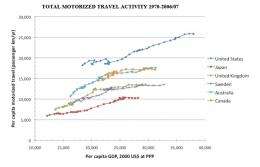January 3, 2011 report
Have we reached peak travel?

(PhysOrg.com) -- Since the 1970s, passenger travel by vehicles and airplanes has grown rapidly in industrialized countries, and the International Energy Agency has predicted steady, though slower, travel growth until 2030 and beyond. However, a new study of eight industrialized countries has shown that passenger travel seems to have peaked in the early 2000s, just before the recent rise in fuel prices. The results suggest that demand for travel has reached a saturation point, which could mean that future projections of carbon dioxide emissions and fuel demand could be lower than previously thought.
The study’s authors, Lee Schipper of the University of California, Berkeley, and Stanford University and Adam Millard-Ball, a doctoral candidate at Stanford University, analyzed travel trends from the US, the UK, Canada, Sweden, France, Germany, Japan, and Australia from 1970 through 2008. For each country, they plotted the distance traveled per capita per year by car, pickup truck, bus, plane, train, light rail, streetcar, and subway, and compared it to the country’s gross domestic product per capita.
They found a correlation between rising prosperity and passenger travel from 1970 to 2003, after which passenger travel stopped growing (while GDP per capita continued to rise). At this peak travel period, GDP per capita was $37,000 in the US and between $25,000 and $30,000 in the other seven countries. During the past few years, motorized travel in the US has plateaued at around 26,000 km/year per person, 10,000 km/year per person in Japan, and between 13,000 and 17,000 km/year per person in the other six countries. (See above graph.)
“Since 2003, motorized travel demand has leveled out or even declined in most of the countries studied, and travel in private vehicles has declined,” the authors wrote in their study. “Car ownership has continued to rise, but these cars are being driven less.”
The researchers speculated that several factors have contributed to the apparent peak in passenger travel. One factor is saturation in vehicle ownership: in the US, there are about 700 cars per 1,000 people (which is more cars than licensed drivers), and about 500 cars per 1,000 people in most of the other countries. Basically, everyone who wants to drive, drives. Since 2007, car ownership in the US has declined due to the recession. Another limiting factor is time: people already spend an average of 1.1 hours per day traveling, and speed limits for the large part remain fixed. Other factors include high gas prices and an aging population that doesn’t commute.
The researchers think that the biggest factor of the travel plateau may be traffic congestion. As Schipper said in an interview with Miller-McCune, “My basic thesis is, 'There ain’t room on the road.' You can’t move in Jakarta or Bangkok or any large city in Latin America or in any city in the wealthy part of China. I think Manila takes the prize. Yes, fuel economy is really important, and yes, hybrid cars will help. But even a car that generates no CO2 still generates a traffic problem. Sadly, what is going to restrain car use the most is that you can’t move.”
Perhaps the biggest advantage of peak travel is that, if passenger travel continues to stay the same while vehicles become more fuel-efficient, then reducing transportation emissions may not be as daunting as previously thought. Today, the average American car uses a third less fuel per mile than in 1973, despite consumer demand for larger vehicles.
Although the researchers note that their results are not conclusive and further research is needed, they conclude that the assumption that travel demand will continue to rise should be treated with caution.
More information:
Adam Millard-Ball and Lee Schipper. "Are We Reaching Peak Travel? Trends in Passenger Transport in Eight Industrialized Countries." Transport Reviews. DOI: 10.1080/01441647.2010.518291. Early version available here.
via: Miller-McCune and TreeHugger
© 2010 PhysOrg.com

















